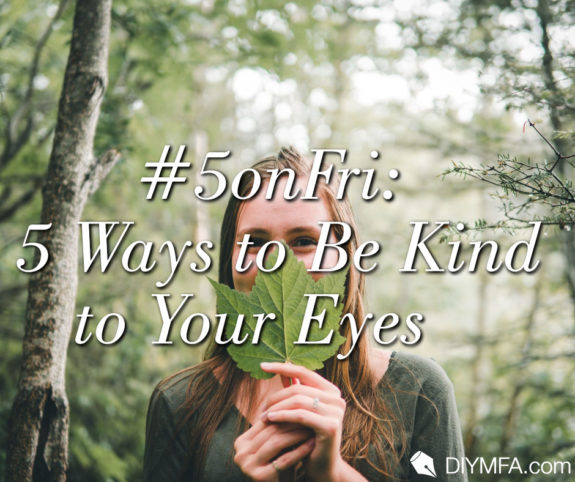I am an alumna of Pixels to Platform and DIY MFA 101. In my writing and life as a writer, I incorporate practices from my teaching as a certified Breath Qigong Yoga and Tai Chi instructor. I am also studying to be certified as a WELL Accredited Professional for health and wellness in building design. I’ve learned that taking care of your eyes is key to reducing mental stress and increasing productivity.
We are spending more time in front of computer screens than ever before. Writers are used to this, but everyone is feeling the effects of increased screen time with virtual events. Eye strain, headaches, and mental fatigue are part of sitting in front of a computer screen for hours. With online burnout, tired eyes create a tired brain, which disrupts the digestive system. Your brain and stomach are linked: when your brain is tense, your stomach is tense too.
The other factor in screen time is blue light. This high-frequency bright light promotes alertness, delaying melatonin production needed for sleep by up to four hours. According to the Institute of Medicine, 50 to 70 million U.S. adults have a chronic sleep disorder, leading to an increased risk of diabetes, obesity, depression, heart attack, hypertension, and stroke.
Cutting back on screen time is tough. But here are five steps you can take to reduce the strain on your eyes and minimize the effects of blue light.
1. Adjust monitor settings
Check your monitor settings for ways to filter out the blue light. My monitor’s color mode is Adobe RGB, the brightness is 40, and the color temperature is 6500K during the day. In my Windows setting I have the nightlight feature turned on and set to 8:30 p.m. This setting displays warmer colors to help you wind down for sleep. You can also set your monitor to display warmer colors at sunset based on your location.
Another option is the f.lux app for Windows or Mac. It creates a custom lighting schedule based on circadian biology adjusted for where you live, when you wake up, and the time of year. As an added bonus it will coordinate with a home’s smart lighting system to warm up color temperature in preparation for bedtime.
2. Assess workspace lighting
Your workspace should have a combination of ambient light and task lighting. I installed an LED tape lighting system at 2,500 Kelvin with a dimmer that works really well at providing both. I keep the light low for ambient light and raise light levels for task lighting. When looking at LED lights, aim between 2,000K (gold) and 3,000K (yellow) for ambient lighting. Blue light starts at 5,000K, with 6,500K the color temperature of daylight for task lighting. A 40 Watt incandescent bulb gives a brightness of 400 lumens, which is good for ambient light. A 60 Watt bulb gives a brightness of 700 lumens, and is best suited for office tasks.
If possible, get some of your lighting from an outside source, such as a window. Focused work increased by 15% for workers with a window view.
3. Take eye breaks
For every hour of work, take a few minutes to reset your eyes. Change your focal length to give your eyes a rest. Look at a point in the distance and let your gaze go soft. This helps the muscles at the sides of your eyes relax.
Next, do some simple eye stretches right at your desk. Close your eyes. Look up, then down. Repeat. Look to your left, then to your right. Repeat. Rotate your eyes clockwise, then counterclockwise. Open your eyes wide, then quickly snap them shut. Slowly open your eyes.
4. Spend time with nature
Take breaks to look at nature. This can be a walk outside, looking at a plant on your desk or a picture featuring nature. Look for images that have soothing colors of blue and green. William James, brother of Henry James, theorized there are two ways of paying attention. Voluntary attention is for tasks that demand attention, such as work or driving. This creates mental fatigue. Involuntary attention is the kind we use in nature that comes to us effortlessly. The soothing sights of trees, birds in flight, or water allow our minds to wander and create mental clarity.
Fractal patterns (repeating patterns in nature) are scientifically proven to relax us. We process patterns in the natural world easily. Center your attention on the veins in a leaf or the branching of a tree for a few minutes until you feel relaxed.
5. Treat your eyes to a spa day
At the end of the day, give your eyes a spa treatment. Steep 2 bags of chamomile tea as if you were preparing a cup to drink. Gently squeeze the tea bags so they aren’t dripping. Place them on your eyes and rest for 20 minutes. Remove the tea bags and lightly cup your hands over your eyes, being careful to not press down on your eyes. Close your eyes and relax for several minutes. This sends energy back to your eyes.
Be kind to your eyes for a happy, healthy, balanced writing life!

Ambre Dawn Leffler writes about communing with nature, loves trees, and is a total weather geek. Learn more about her work at https://ambredawn.ck.page/author-wellness, on Instagram @ambredawnleffler, and twitter @AmbreDLeffler.







